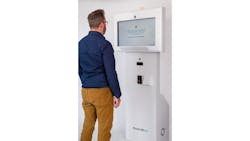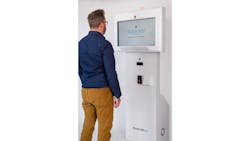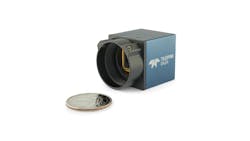Automated Vision Solution Allows Safe Health Screening
Chris Mc Loone
Nuvoola AI (Chambly, Quebec, Canada; www.nuvoola.com) recognized a need for a turnkey solution to provide automated health screening and detection for hospitals and senior residences to limit COVID-19 infections. “They needed a safe way to screen employees and visitors to limit the spread of the virus,” says Nuvoola AI CEO Martin Renière. “Current methods at the time included taking people’s temperature at a distance of less than 2 m, making people sign a visitor log, and making sure people were wearing their masks. All these tasks were performed by employees, who were badly needed somewhere else, or by security guards.”
With an automated screening solution, says Renière, employees can be assigned to perform other strategic duties as opposed to sitting in a lobby to make people sign the visitor log and take their temperature. Risks can be monitored remotely, and organizations can have full visibility as to what is going on over multiple sites at the same time, increasing their ability to react in case of an outbreak. “Moreover,” he adds, “a digitized solution like LUKE AI for Health Screening and Protection (HSP) helps them comply with government regulations more easily.” The automated kiosk not only reduces human error but speeds up the detection process, which helps reduce crowding at the entry point. The system creates auditable logs automatically, which also helps meet government requirements.
LUKE AI
The turnkey system by Nuvoola AI employs the company’s AI engine, LUKE AI. Renière says LUKE AI is “at the heart of all of our SaaS solutions. LUKE AI serves as a platform to develop advanced machine learning models to automate manual tasks. Mainly, we use computer vision to capture data from cameras and turn it into actionable intelligence.” LUKE stands for Learn, Understand, Know, and Execute.
- Learn: The system acquires images (e.g., the face of a driver, employee, or visitor, an employee card, driver’s license, or other documents) thanks to a camera video feed. It can also use data from other sources such as internal management systems.
- Understand: The system creates or validates profiles by recognizing faces and voices, recording language preference, and associating identification information. It trains multifactor AI models for future identification of individuals on the first visit.
- Know: The LUKE™ Neural Network assesses the validity of all variables taken together and determines if the person should be given access using a comprehensive confidence score. It compares the data capture with existing data to validate. It stores all data and presents it on an intelligent, customizable dashboard.
- Execute: The system assesses what the next step should be and takes appropriate action, for example, it can let a person pass or alert personnel to intervene, if necessary.
Automated Vision Solution
The solution Nuvoola developed includes an app that employees use to assess their health status before arriving at work in addition to an onsite, touchless kiosk (Figure 1) that rapidly screens people for symptoms of COVID-19 as they enter buildings. It only takes a few minutes to answer all mandatory health questions. If all the answers are good, the system tells them they can proceed to work.
Once on site, they need to stop at the kiosk, scan their ID or wait for the system to recognize them. Once recognized, the system will validate their answers while taking their temperature three times thanks to a Teledyne DALSA (Waterloo, Ontario, Canada; www.teledynedalsa.com) Calibir™ thermal camera. To ensure accuracy at a distance of 2 m, the camera’s pixel resolution must be at least 640 × 480 pixels.
The kiosk recognizes people by their employee card or by facial comparison and uses an automated process to greet and screen visitors using natural language interactions in French or English, based on their preference. At the same time, the AI-powered kiosk can verify whether a face mask is required and measure body temperature. “Our self-serve kiosks are all equipped with a camera that is placed at the top of the kiosk,” says Renière. “The camera is used to detect if someone is standing in front of the kiosk. In some kiosks, we use facial recognition to recognize the employee within seconds.” The system detects the person’s face and can measure body temperature from the inner eye, according to Renière.
Ambient conditions like heat and humidity can affect the accuracy of a thermal camera’s temperature readings. To ensure accuracy, Nuvoola AI uses a black body that acts as a reliable temperature reference point so the camera can calibrate itself against that reference point.
The company’s newest kiosks have evolved to perform certain services as opposed to only screening people. Renière adds, “With the labor shortage and the self-service technology gaining mainstream acceptance at a rapid pace, we are using our LUKE AI technology to allow government and organizations to offer residents and customers a way to perform certain tasks like renewing an ID and passing a drivers’ license written test on their own without having to wait in line or book an appointment.” The kiosks are now equipped with a node sensor that allows users to interact with the screen without touching it to answer screening questions. Questions are customized based on the location and need. Health questions can be asked to validate a COVID questionnaire or to identify someone.
Taking Action
If a person’s temperature is too high, or if their answers pose a problem from a health perspective, the system tells the person to immediately go home and encourages the person to contact health official and to self-isolate.
In other cases, mainly when an employee isn’t recognized or cannot provide an ID, the system alerts the operators inside the organization that someone needs help. The operator gets a call on a laptop or phone and can talk directly to the person at the kiosk.
Right now, the self-service kiosks aren’t connected to any access control system, but they could be, according to Renière. “Our technology easily integrates with access control systems,” he says. “Signals can be sent to an attendant or operators, it all depends on how the organization wants it. Right now, our system doesn’t notify when an employee arrives, but if a visitor comes in and doesn’t have an appointment, the system sends a message to the attendant.”
The system processes captured data on the LUKE AI platform. The health and screening product keeps specific data. “To comply with our clients’ privacy policy, our system only keeps data that an organization wants to keep like an employee’s name, ID, and body temperature, says Renière. “ISO’s recommendation states that organizations should keep a record of all data related to thermal temperature checks for a minimum of 30 days. This period of time is the maximum incubation time for most infectious diseases. Should a government organization or public health department require longer recordkeeping, the health screening solution can be set up to keep the data for a longer period.”
Thermal Imaging Camera
The Teledyne DALSA Calibir GX camera family (Figure 2) features the company’s latest microbolometer sensor, sensitivity in longwave infrared range of 8-12 µm, both shutter and shutterless operation, and rapid image output on power-up while delivering uniform response over its entire operating temperature range. The GX series also offers Teledyne DALSA’s 21-bit ADC design for intrascene dynamic range without the need for a gain reduction. The camera’s resolution is either 320 × 240 or 640 × 480. Frame rate is 30/60 Hz, and pixel size is 17 µm. I/O options are GigE Vision or CSI-2.
Maximizing Employees
With this health and detection screening system, no operator is required, which makes staff normally responsible for screening available for other tasks. “There is currently a shortage of staff available to perform screening duties, and our automated solution can help with productivity, accuracy, and efficiency,” says Renière. “When solutions leverage artificial intelligence to automate manual tasks, procedures at the gates or lobbies are automated, so there is less chance that a visitor is forgotten, or some element of the screening procedure is evaluated improperly. This means that human error can be reduced or even eliminated, and the screening process can be made faster.”
Another pain point in all industry, according to Renière, is the lack of visibility over multiple sites or points of entry. When everything is manual or only recorded at the end of day, it is impossible to know what is going in real time across sites. By automating the processes and automatically capturing information through the cameras, LUKE AI can aggregate all the information and provide a full picture of what is going on. Alerts can be triggered when something unusual happens and users can quickly identify areas of improvement.


